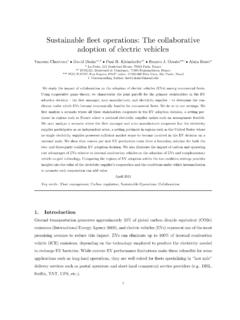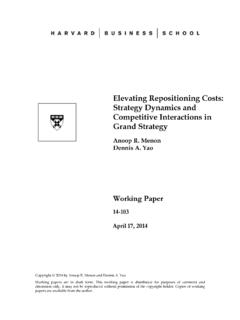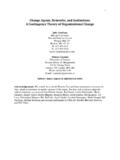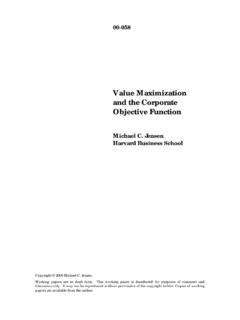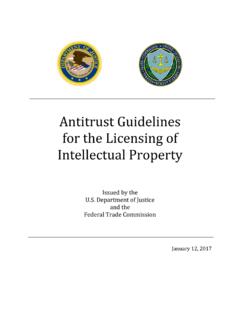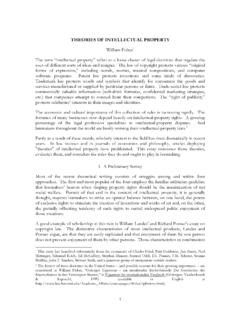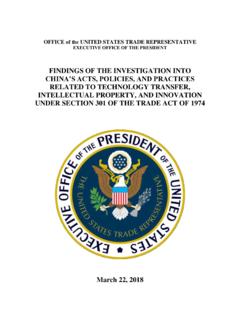Transcription of Strategic Management of Intellectual Property
1 Strategic Management of Intellectual Property : AN INTEGRATED APPROACH. William W. Fisher III. Felix Oberholzer-Gee In many organizations, the R&D, strategy, and legal functions are poorly integrated. As a consequence, firms miss opportunities to create and exploit the value of Intellectual Property . Functional silos are one reason for the lack of integration. More important, however, is the lack of a common framework and even language that would allow engineers, lawyers, and business executives to manage IP assets better. This article provides such a framework. There is no one best way to manage IP and many managers overestimate the attractiveness of using IP to exert market power. Rather, the value of the various means to protect and benefit from IP depends on firm strategy, the competitive landscape, and the rapidly changing contours of Intellectual Property law.
2 (Keywords: Intellectual Property , Innovation Management , Strategic Management , Knowledge Management , Legal Aspects of Business, Licensing). W. hen Pfizer acquired Pharmacia for $60 billion in 2003, the company booked $31 billion in acquired Intellectual Property (IP) rights. Across a broad range of industries and geographies, IP rights now constitute a significant fraction of enterprise value. Yet, in a recent survey of executives who manage IP portfolios, the respondents indi- cated that only one half of corporate leaders understand the value and importance of IP and are actively involved in Strategic planning related to IP. 1 In our experience, this limited integration of IP Management and Strategic planning reflects a number of obstacles.
3 In many companies, the responsibility for IP Management is delegated to legal staff, who tend to be little involved in Strategic planning and decision making. In addition, functional silos within Management often impede a more Strategic view of IP. The separation of IP Management and strategy formulation in turn mirrors the common view that managing IP portfolios, while technically challenging, bears The authors are grateful for the comments of the participants in a workshop held at the Berkman Center for Internet and Society, the participants in a conference on Intellectual Property Management held at the European Patent Office, the participants in the Harvard executive education program on Intellectual Property and Business Strategy , the editors of this volume, and two anonymous reviewers.
4 CALIFORNIA Management REVIEW VOL. 55, NO. 4 SUMMER 2013 157. Strategic Management of Intellectual Property : An Integrated Approach few Strategic consequences. Having developed new William W. Fisher III is the WilmerHale products or services, a simple prescription reads, Professor of Intellectual Property Law at companies ought to obtain patent or copyright pro- Harvard Law School and faculty director of tection for them in the hopes of closing markets the Berkman Center for Internet and Society Felix Oberholzer-Gee is the Senior to competing firms and raising prices. Viewed in Associate Dean for International this way, effective IP Management affords little Development and Andreas Andresen Professor of Business Administration at room for Strategic decision making and can easily Harvard Business School.
5 Be delegated to lower levels in the corporate hierar- chy. Even in companies that perceive the need for an integrated approach to managing IP and setting strategy, the dialog between engi- neers, lawyers, and business executives is often difficult. The specialists lack a com- mon framework and even a language to develop an approach to IP that is broad in its outlook and integrated with the firm's strategy. This article offers such a frame- work. We provide a set of guidelines that help managers and lawyers better navigate the complex landscape of strategy and IP. The device that we use to present our framework is a map. The heart of the map is set forth in the Appendix. A much larger version of the map, which contains many additional case studies and considerable substantive information, is avail- able through the following website: < >.
6 The choices for companies that currently have or might obtain Intellectual Property rights are listed on the left side of the map. The options for firms that currently lack Intellectual Property rights, but are considering entering lines of business that may run afoul of rights held by others, are listed on the right. With the help of the map, we seek to advance and defend the following theses. First, a firm holding an Intellectual Property right can and should choose among five main ways of extracting value from it. All too often, the managers of a firm holding an IP right assume that the best way of using it is to suppress competition in other words, to prevent potential rivals from offering customers an identical or similar product or The resultant market power, it is com- monly thought, will enable the firm to raise the prices it charges for its own products or services and thus increase its Although this is indeed a potential strategy, it is by no means the only option available.
7 In fact, in our experience many managers overestimate the desirability of this option. As the first tier of boxes on the left side of the map indicates, the firm should also consider: selling ( , assigning) the IP. right to another enterprise in whose hands it would be more valuable; licensing the right, perhaps even to competitors; using the right as a vehicle to organize profit- enhancing collaborations with competitors, suppliers, customers, or the developers of complements; and, least obviously, even giving the right away. Similarly, the managers of a firm considering entering a line of business that may implicate IP rights held by other firms too often assume that their best (or only). course of action is to challenge the validity or scope of those rights through litigation.
8 Again, although this is indeed a possible and sometimes attractive strategy, it is not the only option. Others, indicated on the right side of the chart, include: developing an alternative, non-infringing technology; securing a license from the holder of the IP right; building a portfolio of IP rights sufficiently substantial and credible to deter litigation; and, least obviously, deploying a potentially infringing product or service 158 UNIVERSITY OF CALIFORNIA, BERKELEY VOL. 55, NO. 4 SUMMER 2013 Strategic Management of Intellectual Property : An Integrated Approach so widely and rapidly that, by the time it is challenged through litigation, the firm can either persuade the IP holders to grant them licenses or, better yet, can persuade a judge or jury to declare it to be lawful.
9 No one of these strategies is optimal under all circumstances. Which is best varies by context. Not surprisingly, choosing among them requires weighing their relative costs and benefits both short term and long term. All too often, however, managers called upon to make such assessments fail to appreciate the high degree to which those costs and benefits are influenced by the details of the laws governing patents, copyrights, trademarks, and trade secrets. Our final thesis flows naturally from the previous one. Wise Strategic decisions arise out of consultation among managers, lawyers, and the creators of new products and Conversations among managers and creators are, of course, already common. Too frequently, however, lawyers are brought into the mix much too late.
10 The product or service has been designed, a tentative marketing plan is in place, and the lawyers are then asked: May we do this? With distressing frequency, the lawyers (most of whom are temperamentally risk averse) answer: No. This sequence is, at a minimum, wasteful. If managers and lawyers engaged earlier with one another, products and services could be designed in a way that reflects not just market demand, but also the legal opportunities to exploit the resultant To facilitate this collaboration, managers need a keener sense of the legal opportunities and con- straints, and lawyers must become more aware of the Strategic considerations that arise out of their specialized body of knowledge. Everyone, in short, must learn a new language and must speak it more Stated thus broadly, these theses may seem banal.
